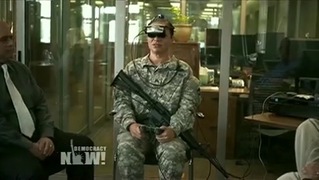
A major New York Times investigation explores the history of one of America’s most important allies in the war against the Taliban: Abdul Raziq. While fighting in Afghanistan, Raziq was frequently praised by American generals and oversaw soldiers “trained, armed and paid by the United States and its allies.” But to civilians in the area, Raziq became known as “America’s monster” after coming to power through years of torture, extrajudicial killing and abduction. Raziq, who was assassinated in 2018, was responsible for the largest known campaign of forced disappearances during America’s 20-year war in Afghanistan. “Raziq was basically the poster child for brutality by the U.S.-backed government,” says New York Times journalist Matthieu Aikins. Despite knowing about the abuses, the U.S. “continued to work with Raziq side by side because he was just so effective in the war.” Aikins argues U.S. “wishful thinking and self-delusion” about the atrocities committed by U.S. troops and allies “is part of the reason why the U.S. failed in Afghanistan despite spending 20 years there and so many hundreds of billions of dollars.”
Transcript
AMY GOODMAN: This is Democracy Now!, democracynow.org, The War and Peace Report. I’m Amy Goodman, with Juan González.
We end today’s show on the U.S. War in Afghanistan and a major investigation by The New York Times into the role of one of America’s most important allies in the war against the Taliban: a man named Abdul Raziq.
The Times writes, quote, “For years, American military leaders lionized Raziq as a model partner in Afghanistan, their 'if only' ally in the battle against the Taliban: If only everyone fought like Raziq, we might actually win this war, American commanders often said. He ruled over the crucial battleground of Kandahar during a period when the [U.S.] had more troops on the ground than in any other chapter of the war, ultimately rising to lieutenant general thanks to the backing of the United States. American generals cycling through Afghanistan made regular pilgrimages to visit him, praising his courage, his ferocious war fighting and the loyalty he commanded from his men, who were trained, armed and paid by the United States and its allies.”
The New York Times continues, quote, “But to countless Afghan civilians under his reign, Raziq was something else entirely: America’s monster,” unquote. According to the Times investigation, Raziq, who was assassinated in 2018, built his success on years of torture, extrajudicial killing and abduction. He was responsible for the largest known campaign of forced disappearances during America’s 20-year war in Afghanistan.
New York Times journalists Matthieu Aikins and Azam Ahmed spent more than a year on the investigation, traveling across Afghanistan, going through thousands of documents — their article headlined “America’s Monster: How the U.S. Backed Kidnapping, Torture and Murder in Afghanistan.”
Matthieu Aikins joins now from Cambridge, Massachusetts, contributing writer for The New York Times Magazine and a fellow at Type Media Center, who is covering conflicts in Afghanistan and the Middle East since 2008. His second piece on Abdul Raziq in The New York Times Magazine is titled “America’s Monster: Who was Abdul Raziq?”
Matthieu, welcome back to Democracy Now! Well, why don’t we start there? Who was this man? What is his record? And why did the U.S. back him?
MATTHIEU AIKINS: Well, I first encountered Abdul Raziq in 2009, when I was just a young freelance journalist, newly arrived in the region. And I was in the borderlands between Afghanistan and Pakistan. I had, by chance, met some drug traffickers, who introduced me to Raziq. He wasn’t much older than I was. He was barely 30, but was already the commander of the border police there. He and his tribal militia were fighting fiercely against the Taliban, but also their tribal enemies, and had gotten the backing of the United States. So, that’s how he began. That’s how he got his start, as the leader of a militia on the border.
But by 2011, as the U.S. surge, the thousands of extra troops ordered by Barack Obama, arrived in country, Raziq was appointed police chief of Kandahar province, which is a very strategic province in southern Afghanistan, focus of the surge. And so, he became a key partner of the United States at the centerpiece of this strategy. And he ruled over not just that province, but eventually became the most powerful man in the south, one of the most powerful in the entire country, became very popular to those who hated the Taliban.
And he was finally assassinated in 2018 by a Taliban undercover hitman. And when that happened, he was standing next to the top U.S. general in the country, General Austin Scott Miller, who lauded him afterward as a great friend and patriot.
JUAN GONZÁLEZ: And you note that despite or in spite of or because of his brutal methods, he was also effective in pacifying or controlling a significant portion of the territory that he was in charge of. Can you talk about that?
MATTHIEU AIKINS: Absolutely. This is a paradox that I wanted to investigate with my stories. We wanted to show the extent of his crimes, you know, that this had happened at this scale, which we did. But I also wanted to understand why, because, you know, the U.S. military, they had this “hearts and minds” strategy, where they were supposed to win over the population, because this war against the Taliban, a guerrilla war, wasn’t a battle between armies for terrain. It was a war over population, right? So, the idea was that they had to win over Afghan heart and minds. But to support someone like Raziq, who committed such brutality, would seem to fly in the face of that. It seems like a paradox.
But what I discovered is, actually, this is very often how these wars are waged, whether they’re by, you know, brutal dictatorships, like in Syria or by the French in Algeria, the U.S. in Vietnam. These counterinsurgencies, these small wars often involve tremendous violence against civilians, because they’re wars for control of population, where both sides, you know, they threaten people, they murder them, they torture them, in order to get them to cooperate or at least not support the enemy. The Taliban did that. They committed violence against civilians. And so did Raziq. And in many ways, he did the dirty work that the U.S. couldn’t allow itself to do, couldn’t admit to itself it was doing, but it was nevertheless effective. And so, this violence, this brutality, it had a logic. It had a reason. It benefited certain people. And that’s one thing I really wanted to show with this piece.
JUAN GONZÁLEZ: And also, you obtained new documents through the Freedom of Information Act, lawsuits and other sources. What did they reveal about how much the U.S. government knew about the atrocities that were being committed by Raziq?
MATTHIEU AIKINS: I mean, they show that the U.S. was aware of his drug trafficking and his involvement in massacres going back to at least 2006. And there were repeated instances where these kinds of abuses came to the U.S.’s attention. So, we got documents that showed that.
But I also just spoke to the top U.S. officials in the country: General John Allen, four-star general, Ambassador Ryan Crocker. They both told me that they had been aware of these allegations against Raziq. General Allen actually stopped handing over prisoners to Raziq in 2011 after he saw evidence that Raziq and his forces had murdered and tortured prisoners. But the U.S. continued to work with him. General Allen’s subordinates continued to work with Raziq side by side, because he was just so effective in the war that they thought they didn’t have any other choice, and so they worked with him despite knowing about these abuses.
AMY GOODMAN: Matthieu, you met with survivors of torture inside Raziq’s prisons, visited morgues where corpses had been exhumed from desert graves. One caption on a photo accompanying your New York Times investigation reads, quote, “Mass graves have been discovered in Kandahar, but under U.S. pressure, the International Criminal Court has de-prioritized investigations into abuses committed by forces like Raziq’s.” Can you explain further?
MATTHIEU AIKINS: Well, you mentioned earlier in your segment, you know, the targeting of ICC officials by the Israeli government that we now are hearing about. Well, let’s not forget that President Trump also imposed sanctions against the ICC prosecutor Fatou Bensouda. And that was mostly in response to the threat that the ICC would investigate war crimes committed by U.S. forces and by U.S.-backed Afghan government forces in Afghanistan. And so, when the new prosecutor came in, Karim Khan, he said that he was going to deprioritize that. He was going to focus on the Taliban, who, of course, have committed their own war crimes against civilians. And the same thing is happening now at the U.N. I think there is this eagerness to turn the page and close this chapter, this shameful chapter in American history, among a number of parties, and to focus on the Taliban.
But I think it’s a tremendous mistake not to learn from the lessons, the hard lessons, of America’s longest war, because there are some very troubling revelations, not just that these crimes were committed, but, as I said, because they’re committed for a reason, because these kind of things work in this kind of war, that there are reasons why militaries historically commit violence against civilians in these kinds of irregular conflicts. And, of course, we live in an age of irregular warfare. Most conflicts that happen worldwide are not between armies on battlefields but are guerrilla wars or internal civil wars. So, it’s absolutely vital that we have a reckoning with the past, in my opinion. And that’s what we’ve been trying to do. We’ve been going back now, because there is a lack of fighting in the country. There’s relative peace. We’re able to get out on the ground and travel the areas that were hard to access before, and get to the bottom of what really happened these last 20 years.
JUAN GONZÁLEZ: And you also write that Raziq’s brutality was — according to you, quote, “stirred such enmity in parts of the population that the Taliban turned his cruelty into a recruiting tool, broadcasting it to attract new fighters” — obviously, against the U.S. occupation. Could you elaborate?
MATTHIEU AIKINS: Well, Raziq was basically the poster child for brutality by the U.S.-backed government for the Taliban, right? He was famous. It was a civil war. So, you know, he was beloved by one side and hated by the other. And that was undoubtedly an important recruiting tool for the Taliban.
But we have to remember, the Taliban, they won, right? And they were incredibly brutal toward civilians. So, there is this assumption, I think a comforting one, a belief that we have, that brutality backfires, that it won’t work. And so, if brutality doesn’t work, then the discussion is over, right? There’s no temptation to use it. But as a matter of fact, it does work in some circumstances. There is a temptation to use it. And it’s clear that the Taliban’s brutality did not prevent them from taking over Afghanistan.
So, we’re really trying to take a deeper look at what really happened and why the U.S. backed Raziq, why he succeeded, but ultimately the republic failed. But I think one important reason why the republic collapsed is because of the kind of dishonesty and criminality that was attached to this sort of brutality. So, the Taliban were open about their brutality. They justified it, you know, in terms of resistance against a foreign occupation and in terms of nationalism and religion, whereas because Afghanistan was supposed to be a democracy that respected human rights, what Raziq was doing had to be hidden. It had to be carried out by criminals. It bred a deeper criminality.
And it also bred a kind of wishful thinking and self-delusion on the part of the United States. I spoke to a lot of U.S. officers who worked with Raziq. And while, on one hand, they knew what was going on, like everyone knew what was going on, on the other hand, they found excuses and ways to say that it wasn’t happening under their watch and they weren’t sure. And that kind of self-delusion and wishful thinking on a larger scale on many issues, I think, is part of the reason why the U.S. failed in Afghanistan, despite spending 20 years there and so many hundreds of billions of dollars.
AMY GOODMAN: I mean, that is really the key point that you take away and the whole issue of what it means when the U.S. backs a kidnapper, a well-known murderer. You’re talking about hundreds and hundreds and hundreds of victims in Afghanistan. Your final thoughts in this last 30 seconds we have, as you conclude that it is part of why the U.S. lost the war in Afghanistan?
MATTHIEU AIKINS: Well, I think that it’s time to have a frank reckoning with our history. And I hope that we’ll continue to do this. This isn’t the last story. We’re working on a series, and we’re going to be speaking with people who want to speak about the truth, because I think it has a lot to say about the other wars that are happening right now around the world, and so we need to take those lessons from our own.
AMY GOODMAN: Matthieu Aikins, we want to thank you so much for being with us, Pulitzer Prize-winning journalist, contributing writer for The New York Times Magazine, New York Times investigation, “America’s Monster.” And we’ll link to your series, a fellow at the Type Center and also at the Radcliffe Center for Advanced Study.
Democracy Now! is produced with Renée Feltz, Mike Burke, Deena Guzder, Sharif Abdel Kouddous, Messiah Rhodes, Nermeen Shaikh, María Taracena, Tami Woronoff, Charina Nadura, Sam Alcoff, Tey-Marie Astudillo, Robby Karran, Hany Massoud, Hana Elias. Our executive director is Julie Crosby. I’m Amy Goodman, with Juan González, for Democracy Now!












Media Options